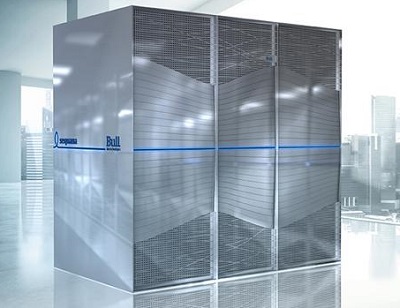
June 19, 2017
By: Michael Feldman
On the opening day of the ISC High Performance conference, Atos announced the Bull Sequana X1310, an ARM-based variant of the company’s Sequana X1000 supercomputer line.
 Bull Sequana is Atos’s flagship HPC blade platform, which up until now was powered primarily by Intel x86 silicon – either Xeon or Xeon Phi processors. Blade options for NVIDIA GPU or Xeon Phi coprocessors are also available. The most distinctive feature of the platform is the Bull eXascale Interconnect (BXI), a proprietary high-performance network designed for massive parallelism.
Bull Sequana is Atos’s flagship HPC blade platform, which up until now was powered primarily by Intel x86 silicon – either Xeon or Xeon Phi processors. Blade options for NVIDIA GPU or Xeon Phi coprocessors are also available. The most distinctive feature of the platform is the Bull eXascale Interconnect (BXI), a proprietary high-performance network designed for massive parallelism.
The new Sequana X1310 blade is comprised of three compute nodes, each outfitted with Cavium’s ThunderX2 processors, the chipmaker’s second-generation ARM v8 server chip. The new system will be available in the second quarter of 2018.
The addition of an ARM blade product places Atos in rare company. Penguin Computing also announced its own ThunderX2-powered cluster platform today. That product, known as the Tundra ES Valkre, can be ordered now and will ship in the third quarter of 2017. Going further back, E4 Computer Engineering, an Italian computer-maker, started offering ThunderX-based clusters back in 2015, under its ARKA brand. Those first generation Cavium chips could be paired with GPUs for additional computational horsepower.
Other OEMs also appear to be moving toward commercial offerings. Cray delivered an ARM-based supercomputer, known as Isambard, to the GW4 HPC alliance in the UK earlier this year. That system is supposedly based on Cray’s CS400 cluster platform, but the company has yet to announce any product plans for the ARM variant. Lenovo, HPE, Dell, Eurotech and Cirrascale have also been fiddling with ARM servers for the HPC market, and a bunch of prototypes have been constructed based on either Cavium or Applied Micro chips.
For its part, Atos has been involved in ARM-powered HPC for a few years now. One of the early systems built for the Mont-Blanc exascale research project was based on an ARM-based prototype of a Bull blade. In the third phase of the project, Atos is supplying a more advanced platform, which will be the basis of the Bull Sequana X1310 product that will ship next year.
The original premise of bringing ARM into the HPC ecosystem is its energy-efficiency. The architecture’s energy-sipping RISC design has certainly served it well for the mobile and embedded computing space, where minimizing the power draw is a critical factor. But it remains to be seen whether a 64-bit ARM architecture with more performant behavior can exhibit the same sort of efficiency relative to a conventional x86 chip.
The less-talked about goal for injecting ARM into the HPC space (and the broader server market in general) is to offer an alternative to Intel and its dominant x86 Xeon product line. ARM’s most obvious advantage here is the ability of multiple vendors to license the chip and construct an array of different implementations targeted to specific types of workloads.
At some point, we may see Atos and other OEMs licensing the ARMv8-A Scalable Vector Extension (SVE) architecture and building a supercomputer based on this much more powerful ARM variant. This is the strategy Fujitsu has undertaken for its Post-K exascale supercomputer.
With Atos and Penguin now testing the waters with the Cavium ThunderX2 in commercial products, we may soon see other HPC server-makers jumping in as well. Watch this space.
